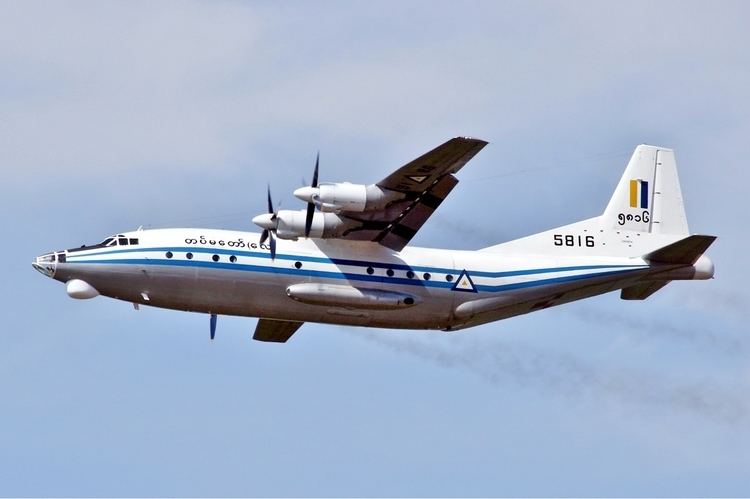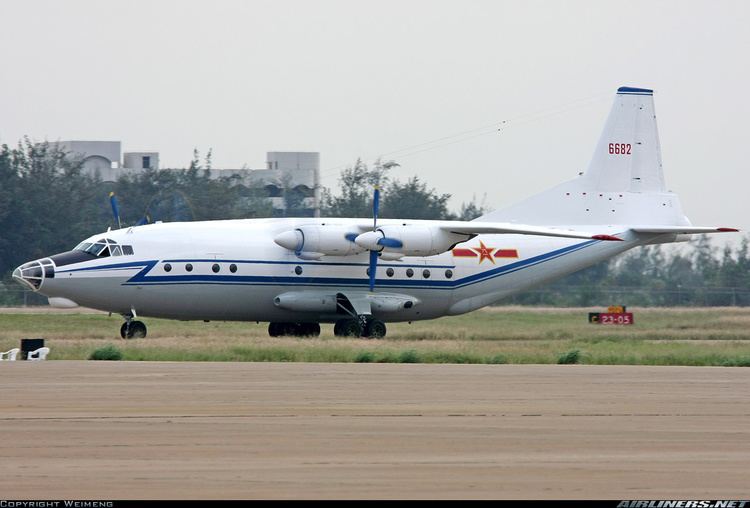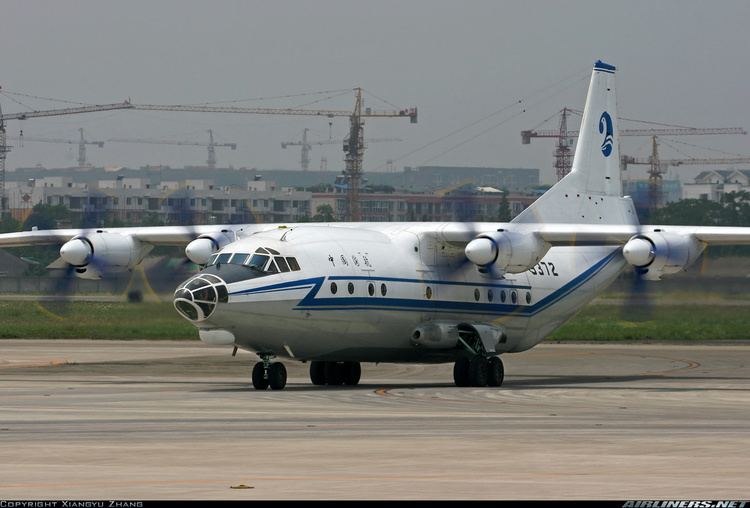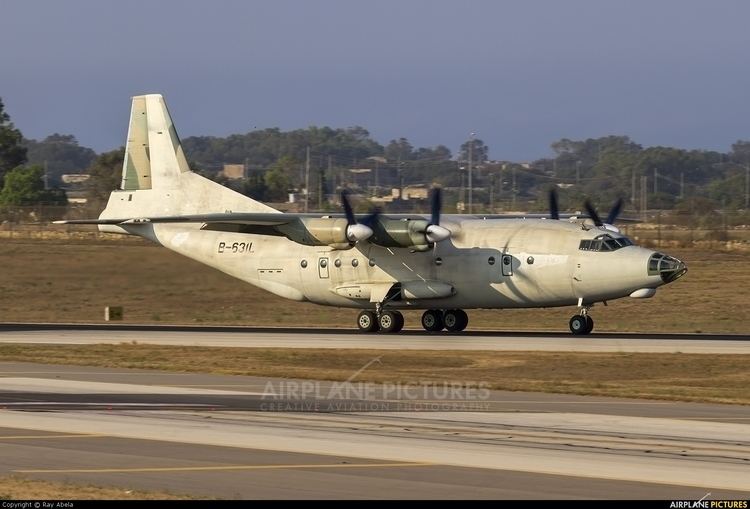Top speed 660 km/h Wingspan 38 m Unit cost 20,000,000–20,000,000 USD First flight December 1974 | Range 5,615 km Length 34 m Engine type Turboprop | |
 | ||
The Shaanxi Y-8 or Yunshuji-8 (Chinese: 运-8) aircraft is a medium size medium range transport aircraft produced by Shaanxi Aircraft Corporation in China, based on the Soviet Antonov An-12. It has become one of China's most popular military and civilian transport/cargo aircraft, with many variants produced and exported. Although the An-12 is no longer made in Ukraine, the Chinese Y-8 continues to be upgraded and produced. An estimated 169 Y-8 aircraft had been built by 2010.
Contents
Design and development

In the 1960s, China purchased several An-12 aircraft from the Soviet Union, along with license to assemble the aircraft locally. However, due to the Sino-Soviet split, the Soviet Union withdrew its technical assistance. The Xi'an Aircraft Company and Xi'an Aircraft Design Institute worked to reverse engineer the An-12 for local production.

Design of the aircraft was completed by February 1972. Major features of the Y-8 included a glazed nose and tail turret derived from that of the H-6 bomber, a roller-type palletized-cargo-handling device instead of the overhead conveyor, and a gaseous oxygen system as opposed to a liquid oxygen system. The original Y-8 inherited the An-12’s twin 23mm cannon tail turret, but this was removed on subsequent variants.

The Y-8 equipped with four turboprop engines mounted under the leading edges of non-swept wings. The wings are attached high on the fuselage, and the tricycle landing gear is equipped with low pressure tires. The earliest versions used for the transportation of freight or troops had two side-hinged, inward-opening doors, while later variants used a rearward-facing ramp to facilitate loading and unloading of the payload. Some specialized versions omit the cargo ramp entirely.

The Y-8 is capable of carrying troops, dropping supplies, parachute drops, and functioning as an air ambulance. It also can be used for commercial uses as a freighter. It is capable of hauling 20 tons of cargo, approximately 96 soldiers, or about 82 paratroopers in the cargo compartment which is 13.5 metres long, 3 metres wide and 2.4 metres high. It can also carry 60 severely wounded soldiers with their stretchers, 20 slightly injured soldiers and 3 medical attendants. Many variants for specialized roles have been built, but information on them can be vague or difficult to obtain due to the secretive nature of the Chinese military.

The Y-8 transport aircraft was put into trial production in the Xi'an Aircraft Factory in June 1972. By December 1974, the first Chinese-assembled Y-8 conducted its maiden flight. Following trial production of the first Y-8s, operations were transferred to the Shaanxi Aircraft Factory. The Shaanxi-produced Y-8s conducted their test flights in December 1975. After a regime of 66 test flights the Y-8 was officially certified for use by the Chinese government. By 1981, the Y-8 entered serial production. Mr. Ouyang Shaoxiu (欧阳绍修) would eventually become the general designer, designing many variants of Y-8, including KJ-200.
In the early 1980s, Chinese officials saw US Army recruiting advertisements featuring parachute extraction of an Army jeep along with troops. The PLA was told to develop this kind of capability. But there were two design problems. One, Y-8 wings have very sharp leading edges, so one wing tends to stall before the other, causing the aircraft to roll inverted as it stalls. The second design flaw as that the cargo deck of the Y-8 had a 10 degree downward slope starting at the landing gear.
When the PLA Air Force started to test parachute extraction, these two design flaws caused a near disaster. The aircraft was flying too fast, and when the parachute started to extract cargo from the hold, the cargo rolled on the deck until it got to the 10 degree downward slope, and there it became airborne while still inside the aircraft. The cargo hit the top of the cargo door on the way out, making it clear that the Y-8 could not do parachute cargo extraction.
In 1986, two engineers from Beijing's Ministry of Aviation visited Lockheed. They could not speak very much English, and the Lockheed-Georgia sales person who met them could not speak Chinese. So for half a day, they did a point-and-grunt tour until they were lucky enough to find a Lockheed employee who could speak Chinese. The Chinese wanted to purchase Lockheed wind tunnel testing on the Y-8 in order to address the stall problem.
As a result of these wind tunnel tests, conducted in 1986, Lockheed was given a contract to do a flight test series on the Y-8. Lockheed was told that flight test data was not provided by the Soviets when they helped China build the Y-8 factory. The flight test series was flown by Lockheed test pilot Hank Dees. Hank had flown the test flight series for the Lockheed L-1011 and later for China's Y-12 in Harbin.
During this flight test series, Hank Dees flew the aircraft to stall speed and taught Chinese pilots how to anticipate a stall in order to prevent letting the aircraft go inverted. As a result of this test flight series, Chinese pilots started to use the 45 degree flap position.
Lockheed's motive for doing flight tests was to demonstrate that China would be better off buying the C-130 rather than trying to improve the Y-8. China did buy C-130's, but the flight test series actually demonstrated that the Y-8 was a more capable aircraft than previously believed.
In the late 1980s, Lockheed Martin, the American manufacturer of the C-130 Hercules, helped China to develop a pressurized cabin for the passenger version of Y-8, resulting in two versions: the first had half of the cabin pressurized and later, the second version in which the complete cabin was pressurized.
In 2001 and 2002, new consulting arrangements between Antonov and Shaanxi resulted in modernized redesigns to the Y-8's wing and fuselage. As a consequence the redesign allows the Y-8's fuel capacity to be increased by 50 percent.
Operational history
Y-8's have been used by the PLAAF and PLANAF in a wide variety of roles and some have been supplied to civilian operators. Export aircraft have been supplied to the Myanmar Republic air force, Sudanese Air Force and the Sri Lankan Air Force. Some Y-8 aircraft were used by the Sri Lanka Air Force as makeshift bombers, dropping bombs from the rear doors, during the country's civil war, losing two units, one to Tamil Tiger anti-aircraft defences and the second to mechanical failure.
KJ-200 Accident
On June 3, 2006, a Chinese KJ-200 'Balance Beam' Airborne early warning and control aircraft crashed in Guangde County in the Anhui province, China. All 40 people on board were killed. The Chinese official explanation was that the accident was due to heavy ice formation on the wings after the aircraft made repeated passes in and out of clouds in bad weather. However, the official Chinese report does not mention the exact type of the airborne early warning aircraft, only claiming that it was a 4-engine large military aircraft. Official Chinese media acknowledged that the platform is Shaanxi Y-8 KJ-200.
In Chinese National Day military parade 2009, the Air Force KJ-200 took the role as a lead plane.
Variants
Operators
Former Operators
Specifications (Y-8 Transport)
Data from Sinodefence.com
General characteristics
Performance
Armament
Twin 23mm cannon tail turret (early models only)
